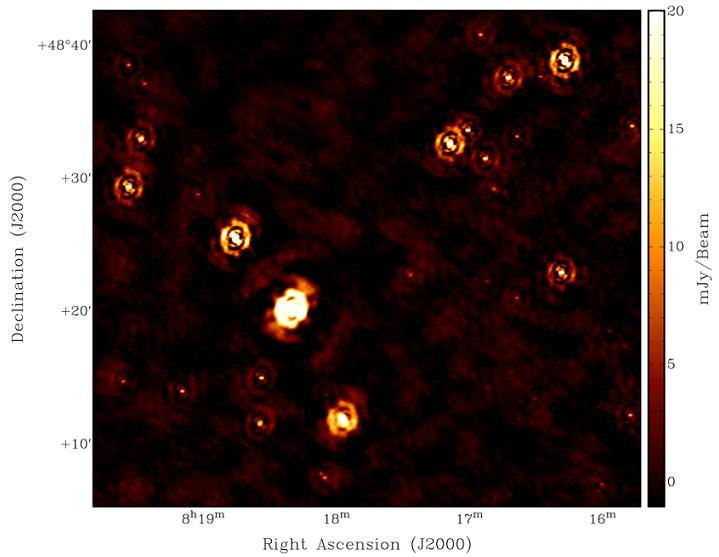[/caption]
The International LOFAR telescope is a Pan-European collaborative project led by ASTRON Netherlands Institute for Radio Astronomy. The radio telescope integrates thousands of simple dipole receivers with effective digital signal processing and high-performance computing. LOFAR can rapidly take in wide areas of the sky, aiming in multiple directions simultaneously. It also utilizes unexplored low frequencies, around around 150 MHz, which allows astronomers new insights. What has LOFAR done so far? Try capturing faint radio sources never revealed before.
An international team led by astronomers at ASTRON and the Kapteyn Institute of the University of Groningen have used the LOFAR telescope, designed and constructed by ASTRON, to make the deepest wide-field images of the sky to date. At the conference, the trouble of dealing with foreground noise was the topic – foreground noise that makes it nearly impossible to get a good radio view of the distant Universe. What researchers are looking for is the Epoch of Reionization (EoR) – a time which is postulated to have occurred in the period between about 400 and 800 million years after the Big Bang. Says the team, “During the EoR the neutral hydrogen was slowly disappearing, probably as a result of the strong ‘ionizing’ power of the first stars and quasars. Detecting the EoR is one of the hottest projects in astronomy today.”
Detecting a signal from a 13.8 billion year old event would be akin to the Holy Grail of radio astronomy, but the team of astronomers based at ASTRON and the Kapteyn Institute of the University of Groningen, headed by Prof. Ger de Bruyn, Dr. Michiel Brentjens, Prof. Leon Koopmans and Prof. Saleem Zaroubi, are willing to sift through the noise to diclose new findings. The LOFAR data images were obtained in a 6-hour synthesis on the night of 29/30 January 2011 and the evening of 1 April 2011 using 18 core stations and 7 remote stations. Signals were recorded with the High Band Antennas blanketing the frequency range from 115 – 163 MHz and then further refined.
One of the fields covered by the radio imaging is centered at the celestial North Pole since it is available year round from LOFAR’s central position. The second field is dedicated to bright, compact quasar 3C196 in the constellation of Lynx. The high resolution images already match – or even surpass – the best published images taken with the Giant Meter Wavelength Radio telescope (GMRT) in India. The images reveal a significant number of both very bright and very faint sources, spanning a so-called dynamic range of more than 200,000:1 in brightness between sources.
“This is an important record for the time being for LOFAR. The image quality, however, is still not perfect and significant improvements can be expected in the months ahead using improved knowledge of the effects of the LOFAR station beams.” says the team. “Continued efforts are also needed to improve the software to deal with imaging artifacts and the ionosphere. These two fields and several others will be observed for about 100 nights to conclusively detect signals from the EoR.”
Sounds like LOFAR is doing great so far!
Original Story Source: ASTRON.


I think this is great stuff. I expect they will first find many distant hard-to-understand radio sources, “galaxies,” that upon interpreting their redshifts via radio frequency, would contradict and be beyond the scope of the BB model and so will probably be interpreted differently.
So what is your prediction based on, what math suggests this, can you state this prediction as a mathematical expression or function using formula others can duplicate.
If this is not a prediction but instead just your expectation, then again, what is your basis for this expectation please.
Are you the same Forrest Noble and Pan Theory person as we have heard from in these comments some time before. The link in your ‘profile’ is 401ed, the name of your dot ORG is also incorrect. What is your intent with these dodges and frauds and mis-representational gimmicks.
A non answer is expected but not predicted, predicated on your past posting.
Mary